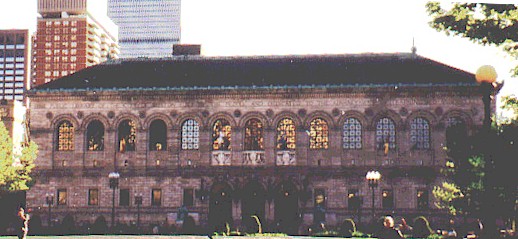
| 
Boston Public Library
Charles McKim of McKim, Meade & White 1887-1895

"Free to All"
A manifestation of late 19th Century civic consciousness,
the Boston
Public Library is one of the most beautiful and celebrated public buildings
outside of the nation's capitol.
Its architect, Charles McKim followed in the footsteps of his mentor H.H.
Richardson in using classical design informed by a wide range of influences.
Both men trained at Ecole des Beaux Arts in Paris after studies at Harvard
University. McKim drafted for Richardson during the construction of near
by Brattle Square
Unitarian Church.
The building is rhythmical, with clear component parts, and a strong relationship
to the ground. McKim had a passion for well laid stone and personally selected
materials. The entry makes lavish use of 400 tons of polished convent sienna
marble arranged with increasing amounts of darker pigment progressing into
the building. McKim's Academic-style Second Renascence design draws on a
wide
range on antecedents, and today is as much a museum of art as it is
a depository of books.
 Philip
Johnson's extension of the library built in 1972 is harmonious with McKim's
masterpiece. Though intentionally subdued, its interior makes noteworthy
use of a "floating foundation" providing sixteen suspended platforms, allowing
great amounts of architecturally sparse open space. University of Oregon
provides excellent history and analysis on their
site. Philip
Johnson's extension of the library built in 1972 is harmonious with McKim's
masterpiece. Though intentionally subdued, its interior makes noteworthy
use of a "floating foundation" providing sixteen suspended platforms, allowing
great amounts of architecturally sparse open space. University of Oregon
provides excellent history and analysis on their
site.
|
|
| INTRODUCING |
|
From the writers of iBoston.org |
|
|
|



